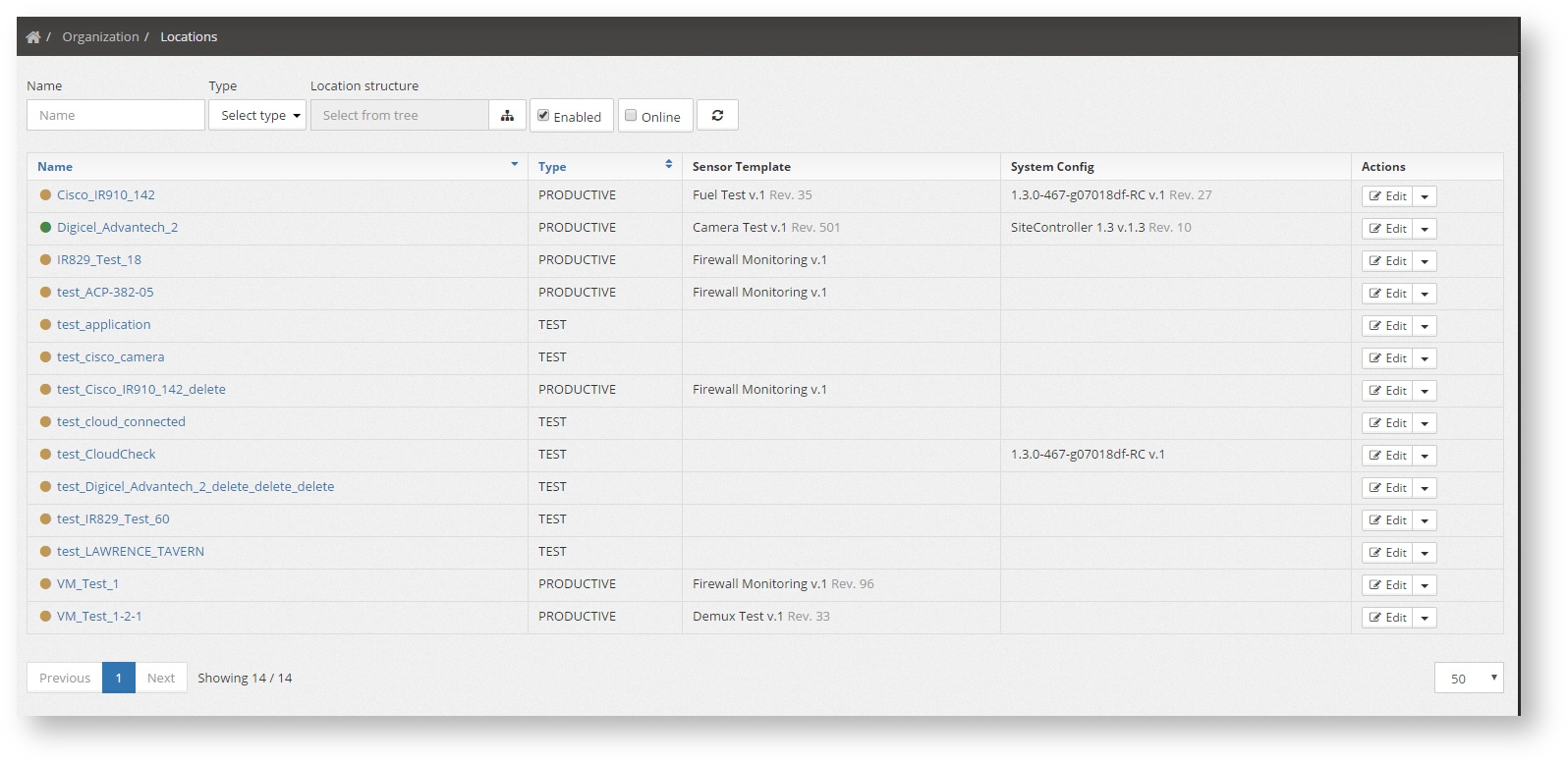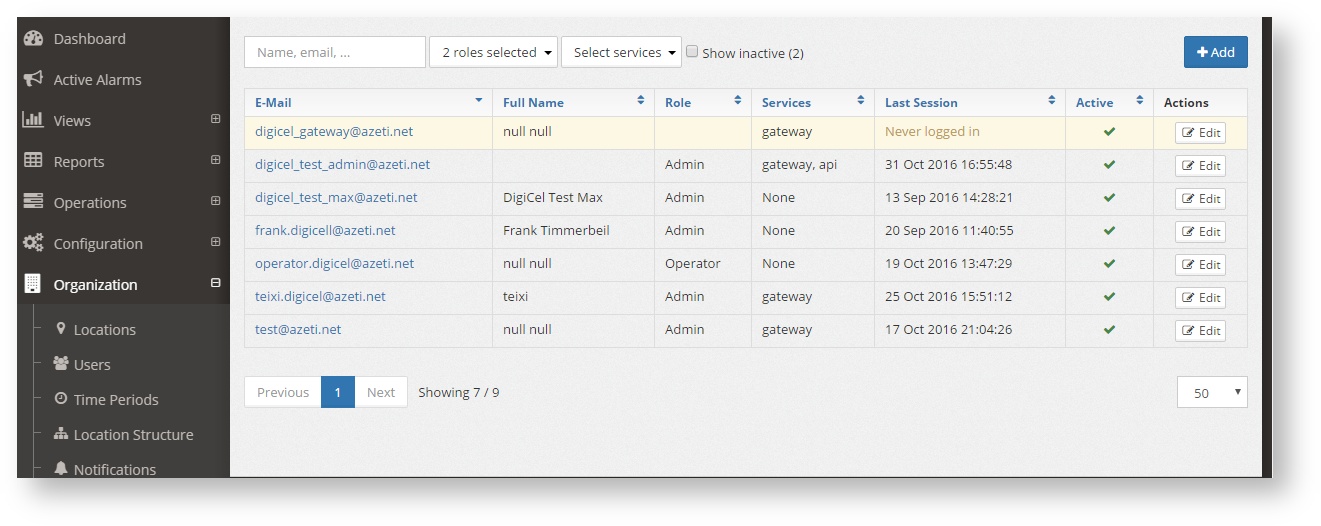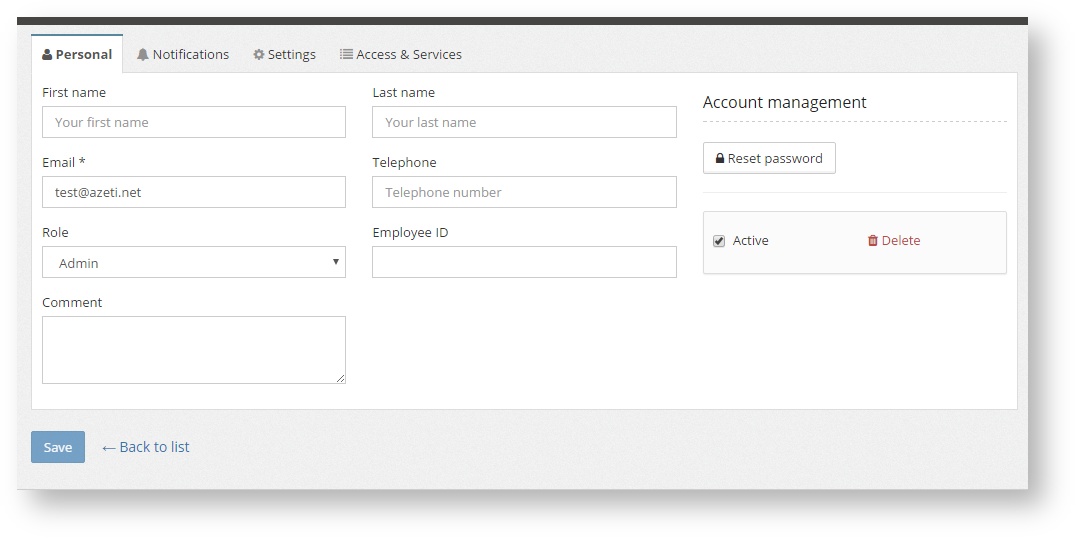Introduction
Locations Management
For the locations management go to Organization → Locations. Here it will be shown a list of all the locations of the organization. A location is defined by a gateway with a SiteController running.
The list shows the following information of each site:
- Connection status: Green if is currently connected, yellow if it is not.
- Name: The location name. By default all new locations will have the name test_SERIAL using the serial name configured on the Site Controller.
- Type: The type of site. There are two possible types;
- PRODUCTIVE: Sites that are consider in production, and are shown in all the lists and reports
- TEST: Sites which are not considered to be fully functional, and are only shown on this list. The are not shown in any other part of the system
- Sensor Template: The assigned sensor template of the site, with a direct link to it
- System Config: The assigned System Config of the site, with a direct link to it
- Actions: Which are:
- Edit: To edit the site basic information (see next section)
- Floor Plan: If a floor plan for the site was loaded, it will take the user to it.
- Deployments: A direct link to the deployments page for this site
- Sensor Template / Location Parameters: A direct link to edit the site template assigned to the site, to customize only for this locations (the changes will not be applied to other sites that use the same site template).
- System Config / Location Parameters: A direct link to edit the system config template assigned to the site, to customize only for this locations (the changes will not be applied to other sites that use the same system config template).
Editing a site basic information
The basic information of a site can be change by clicking on the edit button of the Locations page (Organization → Locations). This will show all the information and will allow the administrator to change it. The page has several tabs:
- General: In this tab the following information can be changed:
- Enabled: The enabled status. If disabled the site will be hidden. It is the previous step to deletion.
- Name: The site name that will be shown on the system.
- Prod/Dev: The type of site, which can be PRODUCTIVE or TEST
- The Address, for information purpose only
- The coordinates of the site, that will be used on the dashboard map.
- The last known IP of the site is shown, but cannot be changed.
- Floor Plan: In this tab a floor plan can be selected an uploaded. It has to be an image (jpg/png)
- Gateways: In this tab is where the site template and system config template is assigned to a site. They can be selected from a drop down menu that shows all the available templates for the organization. It also shows the information about the platform used, the serial configured and the software versions.
- Views: Shows a list of all the views that can be used for this site, with a direct link to them.
- Remote Calls: If the site has any configured remote call (on the System template) it will be shown here.
To make any change permanent always press Save before leaving the page.
User Management
The User Management page allows the Administrator to create, delete and edit all users of the system. It can be reached in Organization → Users.
The page shows all the user, along with their basic information. The E Mail is what is used as username.
Users Roles
Users can have different roles. These are:
- Admin: For users with administrators rights. Are allowed to edit the sites, the templates, add/delete users, etc.
- Operator: For basic users with no configuration rights. They can see all the information and execute actions, but cannot change anyconfiguration
- None: No right to access the server. This are used for users that are only going to receive notifications or for gateways that are going to send data.
Only an Administrator can change the role of a user, but it can be done at any moment.
Services
Users can have enabled two different services:
- Gateway: Users that are used in a SiteController to authenticate when connecting to the server must have this role.
- API: For users that are going to connect to the external API (see External API)
Creating and editing a user
To create a new user click the +Add button. To edit a user, click the Edit button. In both cases the user edition page is shown. Each user has different options in different tabs:
- Personal, where the user personal data,such as phone, name, id, etc. is set. For a new user a password has to be set. For existing users the password can be changed using the "Reset Password" option. Here the users can be deleted with the Delete button. They can also be deactivated, which means that the user will still be in the system but without being able to access the system.
- Notifications, where the user specific notifications settings are configured (see Notifications)
Settings, where the user can language can be selected, enable/disable the sounds and popup notifications, and the timeout. To disable the timeout set it to -1.
Setting the timeout -1 means that the session will never be closed by the system. If a user closes it's browser and opens it again, the session will still be open and the system accessible with the last user privileges. This can be a security risk under certain scenarios.
- Access & Services, to set certain additional privileges to the users, such as Gateway (the username can be used in the gateways for connection) or API (the username can be used by third party software to access the external API)









